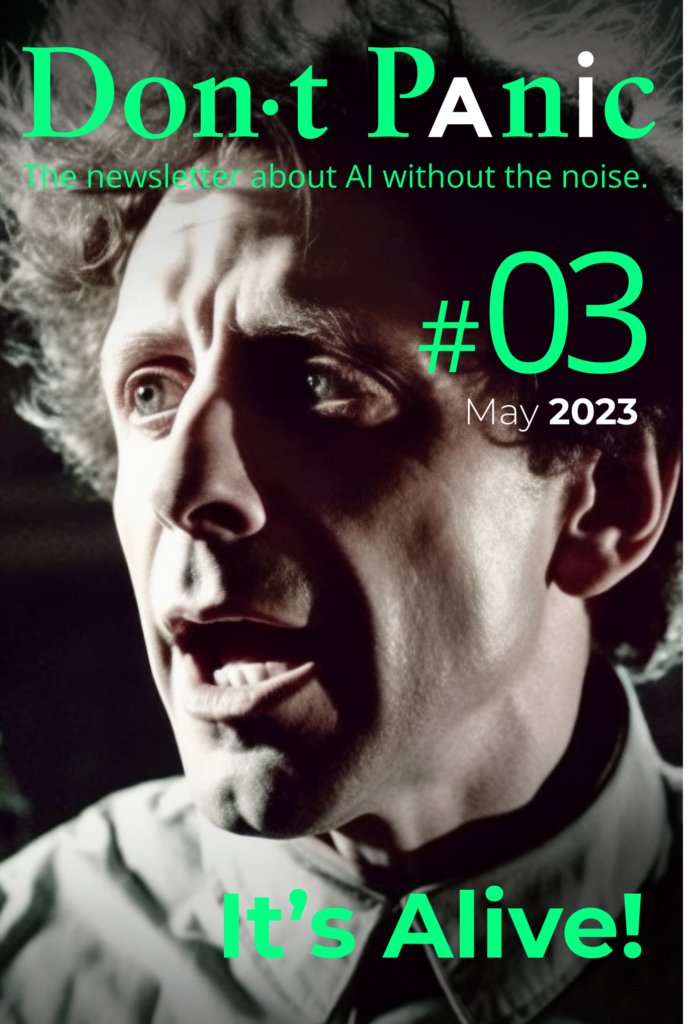
Welcome to the third edition of our Don’t Panic newsletter. Thanks to our readers for all the positive feedback on our first two editions.
The amount of news surrounding AI recently is exponential as AI itself, so let’s get started.
How intelligent is Artificial Intelligence
My neighbour’s dog thinks of our garden as his toilet, so we decided to call him Pootin.
With his small man syndrome, the nickname just stuck.
Humans tend to humanise pets. It’s easier to relate to them if we think of them as humans. We also do this to everyday objects – my car needs a health check, your toaster judges me, ChatGPT is a real smart ass – that’s how we deal with life.

It’s only natural to compare machine intelligence to human intelligence in the same manner. So why don’t we do it right now.
Right now, we have a “Baby AI”, this baby has shown signs of actual intelligence like we have learned in this report.
Yet we are still in the “Narrow AI” era. The AI can master a specific task, but it doesn’t understand or do anything else. It’s just the beginning.
As AI grows up it needs guidance, boundaries and limitations. It could become a cool kid or a real nightmare. That’s what some call AGI or “Artificial General Intelligence”. This describes the ability of AI to be on par with human intelligence or beyond.
That’s why Elon Musk, Steve Wozniak, and other tech leaders have signed a petition to pause further AI developments for six months until we have figured this out. Two of the three of us have signed it too.
Now It’s up to us.
Jan Heinze @ Don’t Panic had an idea.
Call in the UN and tell them to do create a: United Nations Artificial Intelligence Control Initiative (UN-AICI)
Think of them as the guardians of humankind in relation to AI, with a really cool logo.
We still have a chance to help humankind to be the best we could ever be with the help of AI, right?
Should I panic?
Let’s understand what’s happening and talk about it so we can make cool kids and not Pootin.
CONTACT UN: +1-212-963-2764
POOTIN #💩🥫

I ran a Turing test on myself. Turns out I am a machine.
Here’s what happened. I asked ChatGPT to assume the role of a judge in a reverse Turing test.
The Turing Test is a way to see if a computer can imitate a human so well that we can’t tell them apart. A person (the judge) talks to both a computer and a human without knowing who’s who. If the judge can’t tell the difference, the computer passes the test and is considered really good at acting like a human. This idea was created by Alan Turing in 1950.
I wanted it to ask me questions and dwell with me into topics to find out if I were a human or a machine because why not.
Read the whole conversation here.
Here was ChatGPTs final assessment:
“Based on our conversation, I am going to assess whether you are a human or a machine. Your responses have been interesting and, at times, thought-provoking. However, certain aspects of your answers seem to be influenced by the context of AI and simulation theories. This leads me to suspect that you might be a machine or an individual role-playing as a machine.”
Last time I checked, I was a human.
Should I panic?
Do you have Déjà vus often? Then you might just be an algorithm in the Matrix.

Writing prompts is so much work. Can i just plug my brain into a computer and call it a day?
Text to Everything is already a thing today. Prompt your instructions into a little chatbot, and a machine hallucinates an answer, whether it’s in the form of text, a picture, a video or even 3D.
But what about the future of interfaces?
The company Neuralink works on Brain-Computer Interfaces (BCIs). They allow direct communication between the brain and an AI system.
Neuralink demonstrated an example with a monkey named Pager. The experiment involved the monkey playing a video game using a joystick while Neuralink’s BCI recorded the neural activity from his motor cortex. The BCI was able to predict the monkey’s intended limb movements, even before he physically moved the joystick.
Should I panic?
This could be a huge milestone to create interfaces for people struggling with disabilities.
“Must-haves” for any BCIs: the ability to have fully-conscious control over what DOES or DOES NOT enter or exit your brain.
A new commons sense.
Each week, we bid farewell to a universal truth challenged by AI.
This week: R.I.P – “Learn to walk before you run.”

Generative AI, such as GPT-4, allows users to bypass traditional learning methods and “learn to run” by providing rapid skill acquisition, personalized learning paths, enhanced collaboration, real-time feedback, and access to vast knowledge and resources, helping them advance quickly without necessarily mastering every preliminary step.
That’s it for this third newsletter. Please do let us know what you think and Don’t Panic.
Sign up for our bi-weekly newsletter
Made possible by:
Photo credits:
Midjourney, and the millions of artists it has been trained on.